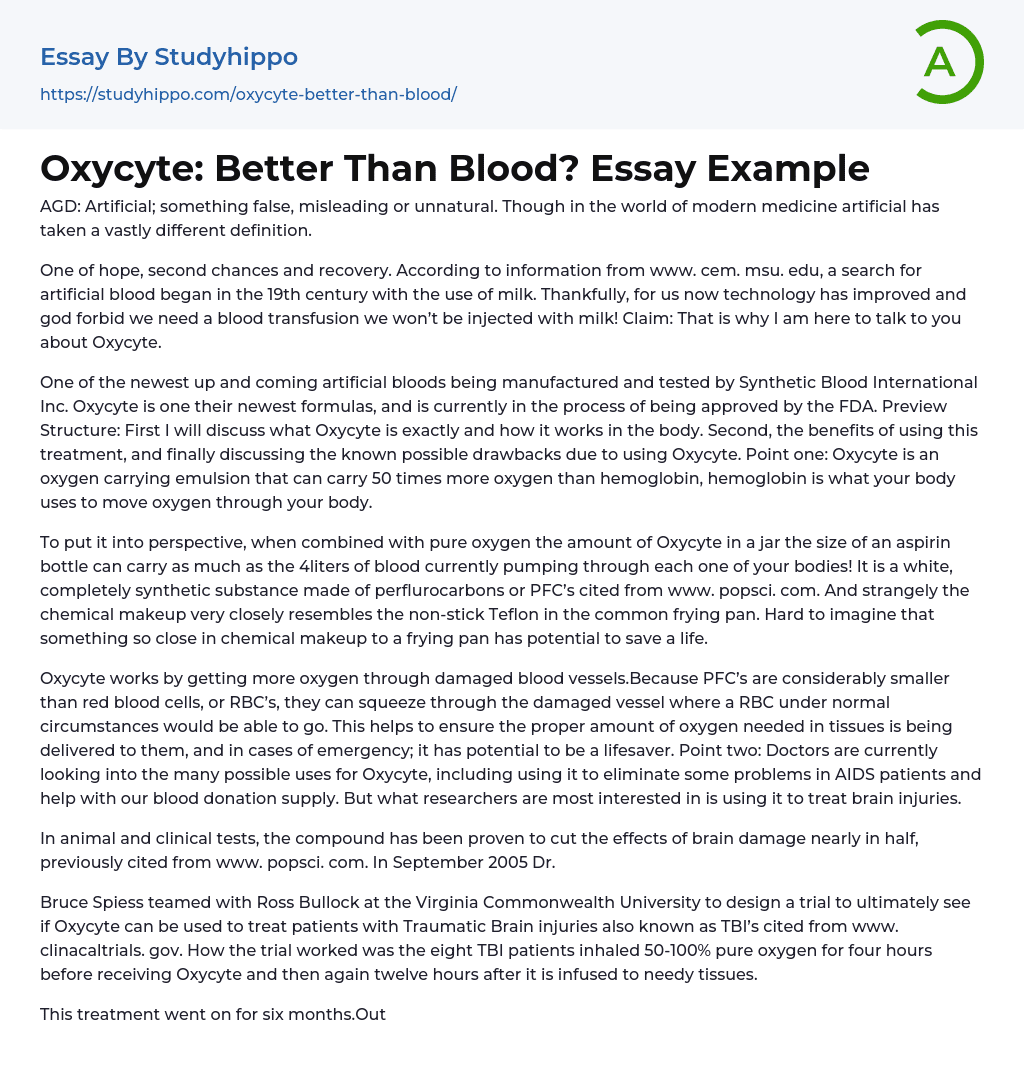The term AGD stands for Artificial, which refers to something that is false, misleading, or unnatural.
The concept of "artificial" has gained a fresh meaning in contemporary medicine, embracing optimism, opportunities for redemption, and the process of healing. For further details, please visit www.cem.
In the 19th century, the search for artificial blood using milk started on msu.edu. However, technological advancements have resulted in the creation of improved alternatives. Synthetic Blood International Inc is currently working on Oxycyte, one of the latest artificial bloods, and its development and testing are underway. At present, this formula is awaiting approval from the FDA. The purpose of this discussion is to give an overview of Oxycyte's function and its role within the body.
The website www.popsci mentions that Oxycyte, an oxygen carrying emulsion, is made of perflurocarbons (PFC’s). This substance
...can transport oxygen more effectively through the body than hemoglobin, which is the body's natural way of transporting oxygen. When combined with pure oxygen, a small jar of Oxycyte (approximately the size of an aspirin) can carry as much oxygen as 4 liters of blood in circulation.
Oxycyte, a chemical compound, has a notable similarity to non-stick Teflon found in frying pans. It is fascinating that something resembling a kitchen utensil could potentially be life-saving. Oxycyte assists in increasing oxygen flow through injured blood vessels. Unlike red blood cells (RBCs), PFCs are smaller and can pass through damaged vessels that RBCs cannot traverse under normal circumstances.
This information was previously referenced from www. This is crucial for delivering the right amount of oxygen to tissues, which is vital for their proper functioning and has potential to save lives in emergency situations. Doctors are
also investigating different applications of Oxycyte, such as its potential benefits for AIDS patients and improving our blood donation inventory. However, the most important focus area for researchers is using Oxycyte to treat brain injuries as it has been shown to decrease brain damage by nearly 50% in both animal and clinical experiments.
Dr. Bruce Spiess and Ross Bullock from Virginia Commonwealth University collaborated in September 2005 to create a trial, aiming to determine the potential use of Oxycyte in treating Traumatic Brain Injuries (TBI). The information is sourced from www. clinacaltrials. gov.
The trial involved eight TBI patients who were given pure oxygen at concentrations of 50-100% for four hours before and twelve hours after receiving Oxycyte. This treatment was administered continuously for a period of six months. Among the eight patients treated with Oxycyte by Spiess and Bullock, only one patient passed away. This trial, along with other studies, has demonstrated the promising potential of Oxycyte. It could potentially become a standard treatment in emergency rooms and hospitals, as well as a valuable resource for military personnel on the battlefield. Oxycyte has the ability to sustain injured soldiers who have suffered major wounds and significant blood loss.
Point three: Although there are several advantages to expect in the further testing of the latest artificial blood, Oxycyte also has its drawbacks. One drawback is the need to inhale pure oxygen along with Oxycyte to fully benefit from it. However, excessive inhalation of pure oxygen can be risky as it can increase free radicals in the bloodstream, leading to damage in the body's tissues and membranes. This goes against the intended purpose of Oxycyte. Furthermore, it should be
noted that once this artificial substance is injected into the body, whether natural or not, it still needs to pass through the liver. Patients have been observed experiencing liver swelling due to absorbing oily molecules from the PFCs (perfluorocarbons) that were being filtered by their livers.
While some individuals have experienced liver swelling, others have had a decrease in platelet count which affects the blood's clotting ability. This is a risk that patients have to consider when deciding to use Oxycyte. In summary, we have discussed the potential benefits of Oxycyte for patients with Traumatic Brain Injuries and for military personnel in improving survival rates for severe wounds. However, we must also take into account the possible side effects associated with Oxycyte. Ultimately, it comes down to whether using an artificial substance for non-natural results is a viable option worth exploring.
Bibliography
- Davis, Nicole. November 2006.
- http://www.popsci.com/popsci/science/9e367f36fca9e010vgnvcm1000004eecbccdrcrd.html
- Effects of Perfluorocarbon Oxygen Delivery in Severe Head Injury.
- http://clinicaltrials.gov/ct/show/NCT00174980;jsessionid=7176E47D93892E78F70FD1B91BC5BE0B?order=40 Synthetic Blood International Inc.
- http://www.sybd.com/
- Cloning essays
- Medical Ethics essays
- Patient essays
- Therapy essays
- drugs essays
- Cannabis essays
- Aspirin essays
- Cardiology essays
- Hemoglobin essays
- Pharmacology essays
- Surgery essays
- alternative medicine essays
- Plastic Surgery essays
- Organ Donation essays
- Vaccines essays
- Medical essays
- Dentist essays
- Psychological Trauma essays
- Physical therapy essays
- Cold essays
- Cocaine essays
- Why Marijuana Should Be Legalized essays
- Drug Abuse essays
- Teenage Drug Abuse essays
- Heart Disease essays
- Artery essays
- Action Potential essays
- Blood essays
- Body essays
- Brain essays
- Childbirth essays
- Eye essays
- Glucose essays
- Heart essays
- Human Physiology essays
- Immune System essays
- Kidney essays
- Muscle essays
- Nervous System essays
- Neuron essays
- Poison essays
- Puberty essays
- Sense essays
- Skeleton essays
- Skin essays
- John Locke essays
- 9/11 essays
- A Good Teacher essays
- A Healthy Diet essays
- A Modest Proposal essays




